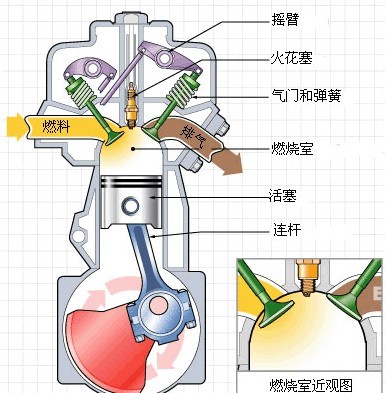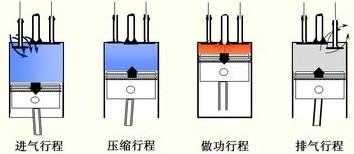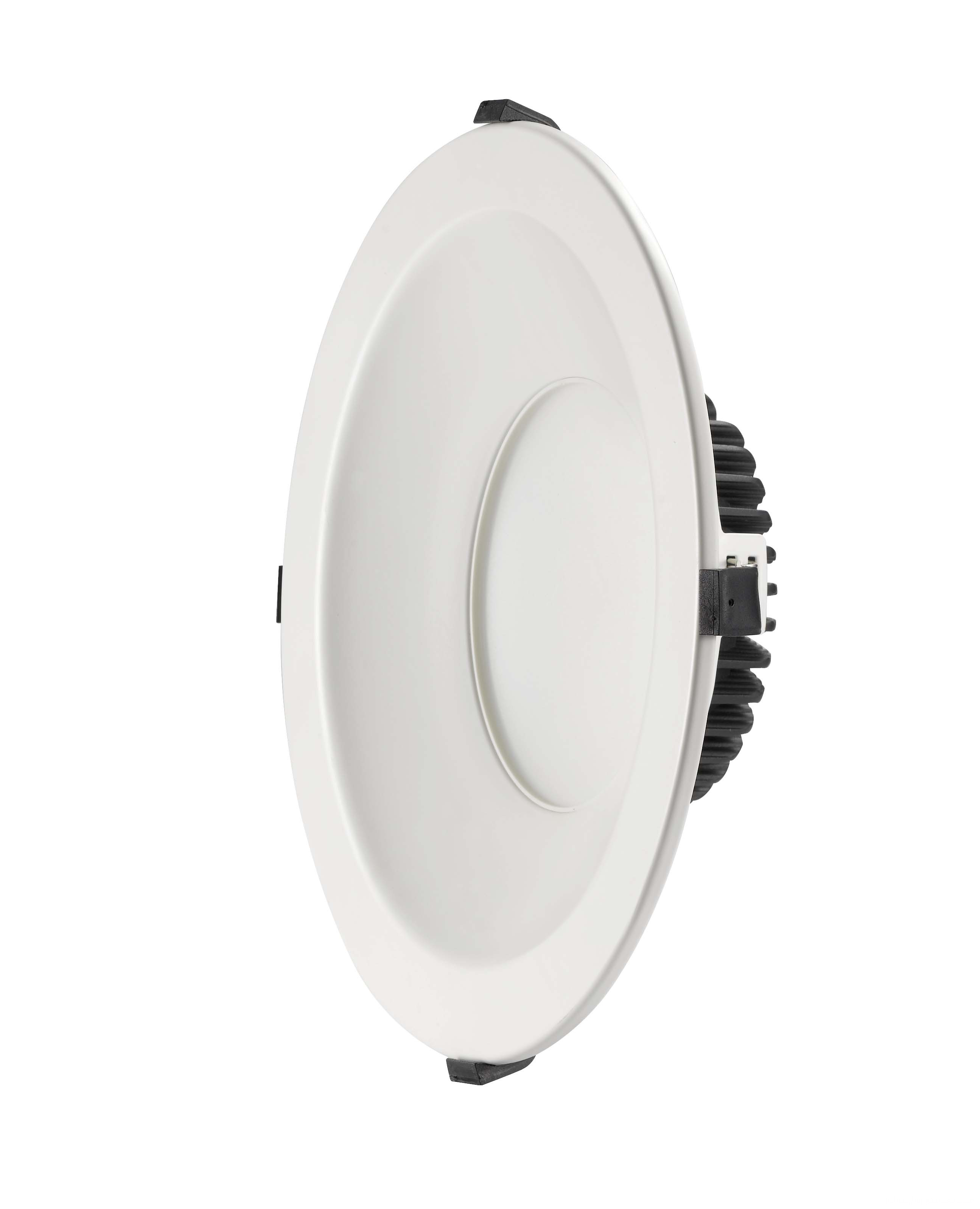Have you ever opened the hood of a car? The car engine (the type of car engine) looks like a mix of messy metal, pipes and wires. You may have read some articles about car engines and know some about car engines, but do you know how car engines work? Let's take a single-cylinder gasoline engine as an example to explain how gasoline engines work.
This article refers to the address: http://
Car engine working principle

A piston is arranged in the cylinder of the engine, and the piston is connected to the crankshaft through a piston pin and a connecting rod. The piston reciprocates in the cylinder and pushes the crankshaft to rotate through the connecting rod. In order to inhale fresh gas and exhaust gas, an intake valve and an exhaust valve are provided.
The piston is at the farthest from the center of the crankshaft, the highest position of the piston, called the top dead center. The top of the piston is closest to the center of the crankshaft, the lowest position of the piston, called the bottom dead center. The distance between the upper and lower dead points is called the piston stroke, and the distance between the connection center of the crankshaft and the lower end of the connecting rod to the center of the crankshaft is called the crankshaft radius. Each stroke of the piston corresponds to a crank angle of 180°. For an engine with a cylinder centerline passing through the crankshaft centerline, the piston stroke is equal to twice the crank radius.
The volume swept by the piston from top dead center to bottom dead center is referred to as the working volume of the engine or the engine displacement, indicated by the symbol VL.
The duty cycle of a four-stroke engine includes four piston strokes, an intake stroke, a compression stroke, an expansion stroke (work stroke), and an exhaust stroke.

Intake stroke
The carburetor-type gasoline engine mixes the air and fuel first in the carburetor outside the cylinder and then into the cylinder. During the intake stroke, the intake valve opens and the exhaust valve closes. As the piston moves from the top dead center to the bottom dead center, the cylinder volume above the piston increases, so that the pressure in the cylinder drops below atmospheric pressure, ie, vacuum suction is caused in the cylinder. In this way, the combustible mixture is drawn into the cylinder through the intake duct and the intake valve.
Compression stroke
In order to make the combustible mixture in the cylinder combust quickly to generate a large pressure, so that the engine emits a large amount of power, the combustible mixture must be compressed before combustion to reduce the volume, increase the density, and increase the temperature. That is, a compression process is required. In this process, the intake and exhaust valves are all closed, and the crankshaft pushes the piston to move from the bottom dead center to the top dead center.
At the end of the compression, the piston reaches the top dead center and a small space is formed above the piston, called the combustion chamber. The ratio of the maximum volume of gas in the cylinder before compression to the minimum volume after compression is called the compression ratio and is expressed as ε:
The higher the compression ratio, the higher the pressure and temperature of the mixture at the end of compression, and the faster the combustion rate, so the greater the power emitted by the engine, the better the economy. However, when the compression ratio is too large, not only can the combustion situation be further improved, but abnormal combustion such as deflagration and surface ignition may occur. Deflagration is an abnormal combustion caused by spontaneous combustion of the end combustible mixture farther away from the ignition center in the combustion chamber due to excessive gas pressure and temperature. At the time of deflagration, the flame propagates outward at a very high rate, and even in the case where the gas does not reach the expansion, the temperature and pressure rise sharply. At the same time, it will cause a series of adverse consequences such as overheating of the engine, power reduction, and increased fuel consumption. Surface ignition is another type of abnormal combustion (also known as hot ignition or pre-ignition) caused by igniting a mixture of hot surfaces and hot places (such as exhaust valve heads, spark plug electrodes, and carbon deposits) in the combustion chamber. When surface ignition occurs, it is accompanied by a strong knocking sound (more boring), and the high pressure generated increases the load on the engine component and reduces the life.
Work stroke
During this trip, the intake and exhaust valves are still closed. When the piston approaches top dead center, the spark plug mounted on the cylinder head emits an electric spark to ignite the compressed combustible mixture. After the combustible mixture is burned, a large amount of heat is released. Therefore, the pressure and temperature of the gas increase rapidly, and the highest pressure that can be achieved is about 3-5 MPa, and the corresponding temperature is 2200-2800K. The high-temperature and high-pressure gas pushes the piston to move from the top dead center to the bottom dead center, and the crankshaft rotates and outputs mechanical energy through the connecting rod, except for maintaining the engine itself to continue to operate, and the rest is used for external work.
Exhaust stroke
Exhaust gas generated after combustion of the combustible mixture must be removed from the cylinder for the next intake stroke.
When the expansion is nearing the end, the exhaust valve is opened, and the exhaust gas is freely exhausted by the pressure of the exhaust gas. When the piston reaches the bottom dead center and then moves to the upper dead center, the exhaust gas is forcibly discharged to the atmosphere. When the piston is near the top dead center, the exhaust stroke ends. The pressure in the cylinder during the exhaust stroke is slightly higher than the atmospheric pressure, which is about 0.105-0.115 MPa. At the end of the exhaust, the exhaust gas temperature is about 900-1200K.
Since the combustion chamber occupies a certain volume, it is impossible to exhaust the exhaust gas at the end of the exhaust gas, and this part of the exhaust gas left is called residual exhaust gas.
In summary, the four-stroke gasoline engine completes one working cycle after four strokes of intake, compression, combustion, and exhaust. During this time, the piston reciprocated four strokes between the upper and lower dead points, and the crankshaft was rotated for two weeks.
Conclusion
All structures of the car engine (car engine maintenance) are for energy conversion, although the engine has been with the car for more than 100 years, whether in design, manufacturing, process, performance, control There has been a big improvement, but the working principle of the car engine has not changed.
10 Inch LED Downlights is can be detachable in 2 parts. For 10 inch LED Downlights, we can do thw watt from 10W to 40W. 10W, 15W, 18W, 30W, 40W are the conventional product. The 6 inch downlight use Samsung SMD5630 chips with Philips or Lifud driver. Dimmable function can also provide. White, black, silver corlor for option. Use high quality PC cover, and adopts precision die-casting aluminum for the module, nice heat dissipation. High CRI >80Ra. High PF >0.95. 100lm/W. For the 6 Inch LED Downlights, it can also up to IP54 protection level. All the Led Downlights is CE RoHS approved. 6 inch LED downlights is easy to transport and install. 230-2600mm hole size is suitable for 6 inch LED downlights.

10 Inch LED Downlights
10 Inch LED Downlights,10 Inch Recessed LED Downlight,10 Inch Square LED Downlights,10 Inch Dimmable LED Downlights
SHENZHEN KEHEI LIGHTING TECHNOLOGY CO.LTD , https://www.keheiled.com
